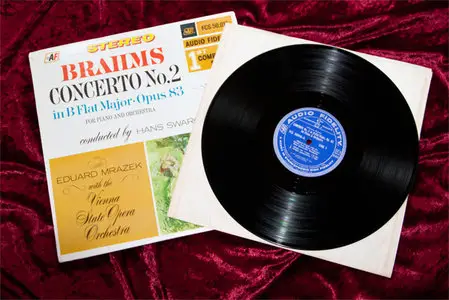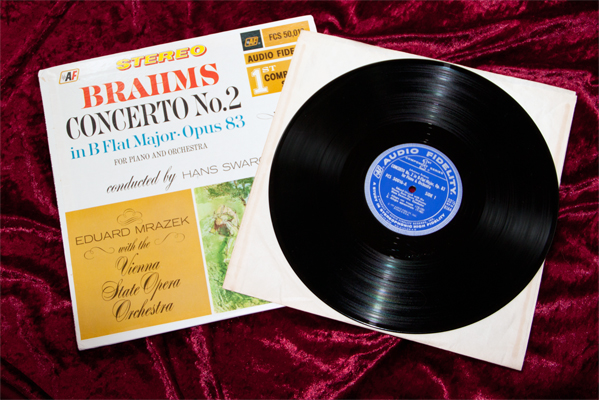Brahms - Concerto No. 2 In B Flat Major, Op. 83
FLAC | NO LOG & CUE | Artwork | 24Bit: 819 MB | 16Bit: 211 MB
Cat#: Audio Fidelity FCS 50,016 | Country/Year: US 1959
MD5 [X] FFP [] CUE [] LOG [] INFO TEXT [X] ARTWORK [X]
webfind [] selfrip [X]
Info:
Johannes Brahms / Eduard Mrazek - Hans Swarowsky - Vienna State Opera Orchestra - Concerto No. 2 In B Flat Major, Op. 83 For Piano And Orchestra
Label: Audio Fidelity
Catalog#: FCS 50,016
Format: Vinyl, LP
Country: US
Released: 1959
Genre: Classical
Style: Classical
Tracklist:
A1 Allegro Non Troppo
A2 Allegro Appassionato
B1 Andante
B2 Allegretto Grazioso
Discogs Url: http://www.discogs.com/release/2349612
Johannes Brahms (7 May 1833 – 3 April 1897), was a German composer and pianist, one of the leading musicians of the Romantic period. Born in Hamburg, Brahms spent much of his professional life in Vienna, Austria, where he was a leader of the musical scene. In his lifetime, Brahms's popularity and influence were considerable; following a comment by the nineteenth-century conductor Hans von Bülow, he is sometimes grouped with Johann Sebastian Bach and Ludwig van Beethoven as one of the Three Bs.
Brahms composed for piano, chamber ensembles, symphony orchestra, and for voice and chorus. A virtuoso pianist, he gave the first performance of many of his own works; he also worked with the leading performers of his time, including the pianist Clara Schumann and the violinist Joseph Joachim. Many of his works have become staples of the modern concert repertoire. Brahms, an uncompromising perfectionist, destroyed many of his works and left some of them unpublished.
Hans Swarowsky (September 16, 1899 – September 10, 1975) was an Austrian conductor,
Swarowsky was born in Budapest, Hungary. He studied the art of conducting under Felix Weingartner and Richard Strauss.[1] His teachers in musical theory included Arnold Schoenberg and Anton Webern.
Herbert von Karajan invited him to take on the permanent position as conductor of the Vienna State Opera[2]
He became a professor of conducting at the Vienna Music Academy. His many conducting students included Leonid Nikolaev, Paul Angerer, Claudio Abbado, Iván Fischer, Jesús López-Cobos, Zubin Mehta, Miltiades Caridis, Alexander Alexeev, Giuseppe Sinopoli, Gianluigi Gelmetti, Brian Jackson, and Albert Rosen. Swarowsky's lectures and essays were collected into the publication Wahrung der Gestalt (Keeping Shape), which today serves as an encyclopaedia for performance and conducting.[3]
He died in Salzburg, Austria a few days before his 76th birthday.
The Vienna State Opera (Wiener Staatsoper) is an opera house – and opera company – with a history dating back to the mid-19th century. It is located in the centre of Vienna, Austria. It was originally called the Vienna Court Opera (Wiener Hofoper); in 1920, it was renamed the Vienna State Opera. The members of the Vienna Philharmonic are recruited from its orchestra.
The small record company Audio Fidelity Records, in New York City, released the first mass-produced stereophonic disk in November 1957. Sidney Frey (1920–1968), founder and president, had Westrex, owner of one of the two rival stereo disk-cutting systems, cut a stereo LP disk for release before any of the major record labels, several of which had the Westrex equipment but had not yet produced a stereo disk.[1] Side 1 was the The Dukes of Dixieland, Side 2 was railroad sound effects. On December 16, 1957, Frey advertised in the trade magazine Billboard that he would send a free copy to anyone in the industry who wrote to him on company letterhead.
That move generated a great deal of publicity and launched a revolution in the way the world listens to music: on two channels, for two ears, in stereo. Frey promptly released four additional stereo disks. The equipment dealers had no choice but to demonstrate on Audio Fidelity Records. Frey became known as Mr. Stereo during that era.
Stereophonic sound was not entirely new to the public. In 1952, sound engineer Emory Cook developed a stereophonic disk that used two separate grooves and playback needles; the following year he had a catalog of about 25 disks available for audiophiles. Multi-channel sound was integral to the widescreen motion picture processes Cinerama (1952) and CinemaScope (1953). And stereophonic audio tapes had been commercially available to audiophiles, although expensive, since the mid-1950s. After the release of the Audio Fidelity demonstration disks, the other spur to the popularity of stereo disks was the reduction in price of a stereo magnetic cartridge, for playing the disks, from $250 to $29.95 in June 1958.[2] That summer, the Audio Fidelity release Marching Along with the Phenomenal Dukes of Dixieland, Volume 3 became the first mass-produced stereo record available to the general public.
In the summer of 1958, Audio Fidelity recorded 13 classical LPs in London's Walthamstow Town Hall. The orchestra was the specially-formed Virtuoso Symphony of London, which consisted of top London orchestral players and instrumentalists. However, once these recording sessions were over, it was never heard of again. Six of the LPs were conducted by Alfred Wallenstein, who concentrated on the symphonic repertoire (Brahms's 4th Symphony, Tchaikovsky's Pathetique, Berlioz's Symphonie Fantastique, and so on) and six by Arthur Winograd (both conductors were ex-cellists) who recorded lighter fare, such as Operatic Marches and Popular Overtures. The 13th LP (Strauss Waltzes) was conducted by Emanuel Vardi. The LPs were expensively produced and retailed at a very high price but reviews of the time were divided between critics who found the stereo sound immensely vivid and others for whom it was over-modulated to the point of distortion. wikipedia
Notice: This recording has some constant crackle coming with it. I decided to share it anyway due to the rarity of it.
=Hardware=
Vacuum cleaned LP>
Shure M97xE>
Dual CS 505-3>
Handcrafted low capacitance custom cables, teflon® insulated & silver-plated coaxial conductors>
Kenwood C1 Custom Revision I>
- Phono Stage input capacitors replaced by Polypropylen/Styroflex types
- All electrolytic capacitors in signal chain replaced by foil capacitors
- Electrolytic capacitors not mounted by manufacturer onto the RIAA stage power Supply refitted (Philips NOS types)
- Old JRC OpAmps replaced by Burr Brown and Analog Devices OpAmps resp.
Handcrafted low capacitance custom cables, polyethylene insulated twinaxial conductors>
Audiotrak Prodigy 7.1 HiFi w/ AD712 OpAmps @ 24/96>
HDD
=Software=
Wavelab 6.11 (Algorithmix Pro)
Adobe Audition 3
ClickRepair 3/0
Trader´s Little Helper (FLAC)
+16Bit Version:
Izotope Rx Advanced 1.21
Resampled:
-Ultra Steep, linear phase
Dithered:
-MBIT+ Medium
-Noise shaping light
-Dither amount normal
Date of rip: 2010-07-09
Please keep the info sheet included if you share this!
Download as:
Flac (Compression Level 8)
Links:
24Bit/96kHz Version
[rapidshare.com/150 MB Splits]
Part 1
Part 2
Part 3
Part 4
Part 5
Part 6
16Bit/44.1kHz Version
[rapidshare.com/150 MB Splits]
Part 1
Part 2
Interchangeable Mirror:
24Bit/96kHz Version
[filefactory.com/150 MB Splits]
Part 1
Part 2
Part 3
Part 4
Part 5
Part 6
16Bit/44.1kHz Version
[filefactory.com/150 MB Splits]
Part 1
Part 2
Password:
finest-hq-audio
Check my blog for other lossless uploads:
http://www.avaxhome.ws/blogs/luckburz



